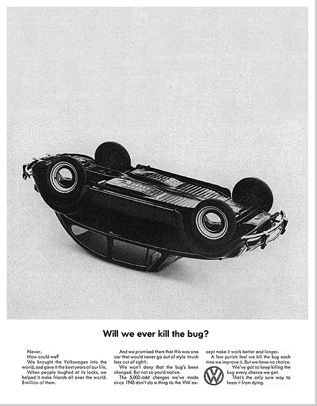The ’50s and ’60s saw advertising transform into a modern approach in which creativity was allowed to shine, producing unexpected messages that made advertisements more tempting to consumers’ eyes.
The Volkswagen ad campaign—featuring such headlines as “Think Small” and “Lemon” (which were used to describe the appearance of the car)—ushered in the era of modern advertising by promoting a “position” or “unique selling proposition” designed to associate each brand with a specific idea in the reader or viewer’s mind. This period of American advertising is called the Creative Revolution and its ‘archetype’ was William Bernbach alongside the DDB agency.
Think Small was an advertising campaign for the Volkswagen Beetle, created by Julian Koenig at the Doyle Dane Bernbach agency in 1959. It was ranked as the best advertising campaign of the 20th century by Ad Age.
The campaign has been considered so successful that it “did much more than boost sales and build a lifetime of brand loyalty […] The ad, and the work of the ad agency behind it, changed the very nature of advertising—from the way it’s created to what you see as a consumer today.”
And what a concept… At a time when the US consumers were being urged, cajoled and ‘persuaded’ to “think big” along comes this one ad suggesting the opposite.
Looking back at the context of that time, it appeared ludicrous. Why? Simply because Doyle Dane Bernbach (DDB) essentially took a German car originally created for Adolph Hitler (the Volkswagen Beetle) and sold it to post-war Americans through radically styled advertisements.
After the United States had been on the winning side of World War II 15 years earlier and had become a world and consumer superpower, cars began to be built for growing families with Baby Boomer children and “Americans obsessed with muscle cars”. The Beetle, a “compact, strange-looking automobile”, was manufactured in a plant in Wolfsburg, Germany, which was perceived to make it more challenging to sell the vehicle (being that the car was designed in Nazi Germany). Existing advertisements for automobiles at the time focused on providing as much information as possible to the reader rather than focusing on persuading the reader in purchasing a product, and the advertisements were typically rooted more in fantasy than in reality.
The ongoing concept for automobile advertisements was to show people, proud owners and passengers evoking great joy and satisfaction about these new shiny big acquisitions. Commercial photography was then in its infancy and was not preferred when it came to capturing the ‘essence’ of the automobile; a great deal of automotive images were multiple illustrated artwork featuring all the exciting features of the vehicle. The advertisements were visually colorful; you can’t miss them with their hand-lettered headlines, big illustrations and large logotypes. Every automobile ad then began saying the same thing: Oldsmobile proudly proclaimed “You’ve got to drive it to believe it!”, Chevrolet expounded “Filled with grace and great new things,” while Buick promised “You can make your ‘someday’ come true now ” or “Here you go in greatness”. The catch words were: “New, Shiny, Big and Great Features!”
Julian Koenig, the copywriter behind many famous advertising campaigns, teamed with Helmut Krone to create the “Think Small” and “Lemon” ads for Volkswagen under the supervision of William Bernbach. DDB built a print campaign that focused on the Beetle’s form, which was smaller than most of the cars being sold at the time. This unique focus in an automobile advertisement brought wide attention to the Beetle. DDB had “simplicity in mind, contradicting the traditional association of automobiles with luxury”. Print advertisements for the campaign were based mostly on the idea of filling the visual field with white space and a small image of the Beetle, idea that was meant to emphasize the simplicity and minimalism of the vehicle. The text and fine print that appeared at the bottom of the page listed the advantages of owning a small car but also challenged the consumer to go further, to get an insight of what exactly the product is, its advantages and the reasons that can stand behind choosing the Beetle instead of all the other ‘big’ American cars .

Volkswagen’s “Think small” advertisement had lots of white space, the product advertised was miniscule, the headline lacked news value and worse of all… it was in black and white! The ad campaign however generated favourable publicity because the advertisements were brilliantly written, for instead of marketing it to consumers as a luxurious, spacious vehicle as all its competitors were doing, it focused on the benefits of its compact size and affordability.
A reader of that time, flipping through a magazine full of articles and colorful advertisements would suddenly turn the page and see a minimalistic ad with a tiny photograph, “realistic” against all those ‘artificial’ illustrations, of a Volkswagen and the headline “Think Small.” Some might even say that the message was very reassuring and confident in comparison to other examples from that period.
The advertisements were brilliant on a visual level – the contrast of empty space caused any image in close proximity to immediately pop from the page, independent of its size and color.
This was a witty, charming, and intelligent approach . This was Bernbach’s approach – simplicity before complexity. Bernbach was THE MAN who changed the way we make ads…







This is a find 🙂
Yours Joblessly,
The Jobless Ideator